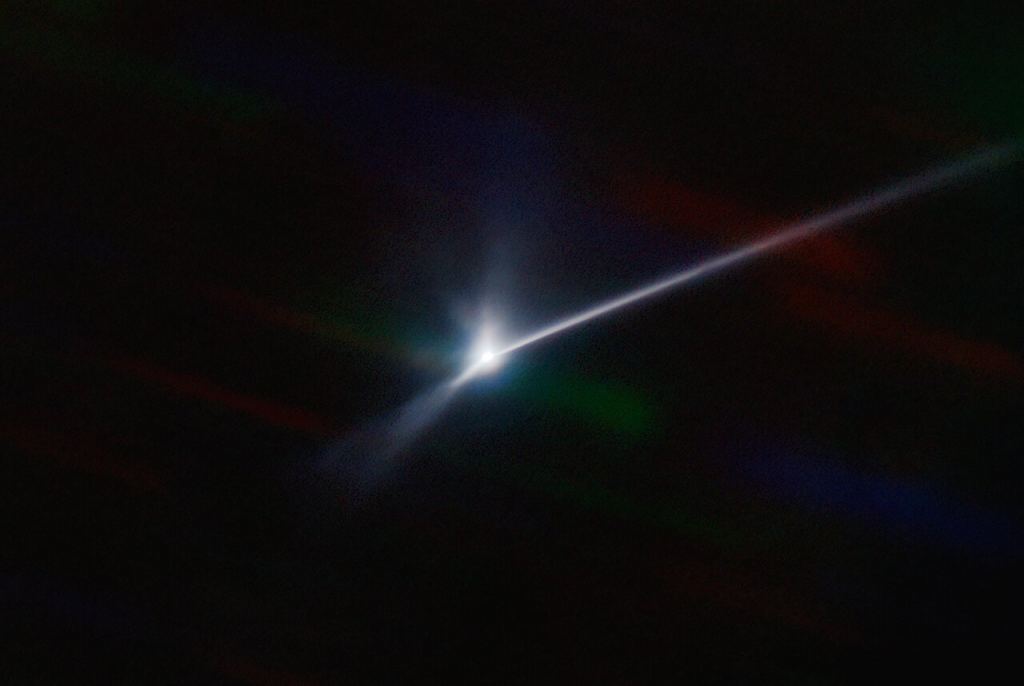More images and details keep coming in about the asteroid intentionally smashed by NASA’s Double Asteroid Redirection Test (DART) spacecraft last week, and this latest image is stunning. A telescope in Chile called SOAR took an image of the asteroid Dimorphos two days after the impact by DART and found the asteroid is trailing a stream of debris more than 10,000 kilometers (6,000 miles) long. However, other reports indicate that the debris trail could now be as long as 50,000 km (31,000 miles), and could still be growing.
Astronomers using the NSF’s NOIRLab’s SOAR telescope in Chile captured the vast plume of dust and debris blasted from the surface of the asteroid Dimorphos by NASA’s DART spacecraft when it impacted on 26 September 2022. In this image, the dust trail is more than 10,000 kilometer long. Credit: NOIRlab.
Astronomers Teddy Kareta from the Lowell Observatory and Matthew Knight from the US Naval Academy used the 4. 1-meter Southern Astrophysical Research (SOAR) Telescope at the Cerro Tololo Inter-American Observatory in Chile. They captured the best image yet of the huge plume of dust and debris that was blasted from the asteroid’s surface by DART.
The astronomers said that the dust trail seen here is the ejecta that has been pushed away by the Sun’s radiation pressure, much like the tail of a comet. In this image, the ejecta can be seen stretching from the center to the right-hand edge of the field of view at about 3. 1 arcminutes long.
With Dimorphos’ distance from Earth at the time of the observation, that would equate to at least 10,000 kilometers (6,000 miles) from the point of impact. “It is amazing how clearly we were able to capture the structure and extent of the aftermath in the days following the impact,” said Kareta. However, according to a Facebook discussion group for the Near-Earth Object Confirmation Page (NEOCP), astronomer Alain Maury said on October 3, the tail has now grown to 13 arcminutes long.
That means by now the ejecta tail could measure at least 50,000 km (31,068 miles) long. You can see an animation of the evolution of the debris tail at this link. Knight said that they plan to use SOAR to monitor the ejecta in the coming weeks and months, and we hope to be able to share more high-resolution images of the debris trail.
DART intentionally crashed into Dimorphos, which is a moonlet that orbits a larger asteroid Didymos, on Monday September 26, 2022. This was the first planetary defense test in which an impact of a spacecraft attempted to modify the orbit of an asteroid. The DART team will need several weeks of analysis to determine if and by how much the orbit of Dimorphos around Didymos was changed.
SOAR Telescope with snow on mountain. Credit:CTIO/NOIRLab/NSF/AURA/J. Fuentes While creating a debris field and ejecta would not be optimal if an asteroid was coming near Earth, tests like this are critical if planetary scientists want to understand how asteroids respond to impacts, especially if the goal is to divert it from hitting Earth.
Scientists want to better understand the amount and nature of the ejecta resulting from an impact, and how that might help to modify an asteroid’s orbit. “Now begins the next phase of work for the DART team as they analyze their data and observations by our team and other observers around the world who shared in studying this exciting event,” said Knight. Further reading: NOIRLab press release The post After Getting Slammed by DART, Asteroid Dimorphos has Grown a Tail appeared first on Universe Today.
.
From: universetoday
URL: https://www.universetoday.com/157939/after-getting-slammed-by-dart-asteroid-dimorphos-has-grown-a-tail/



